General Characteristics & Culture:
Culture & Growth: Epimediums are easy to grow, long-lived shade perennials that thrive in well-drained, humus-rich, moisture retentive soils. Although many species grow in limestone soil in China, they also have grown very well here in the slightly acid soils of north central Massachusetts. The deciduous species native to Japan (and sometimes Korea) E. diphyllum, grandiflorum, and sempervirens, grow on slightly acidic soils in their native habitat. They can be planted in partial sun (with adequate moisture) in northern latitudes; but need more shade further south. Too much sun will scorch the leaves, making them look unsightly, but will not kill the plant. They are tough, and once established, many tolerate dry shady garden sites where other plants fail. This makes them good choices for planting under shallow-rooted trees and in gardens that experience periodic drought.
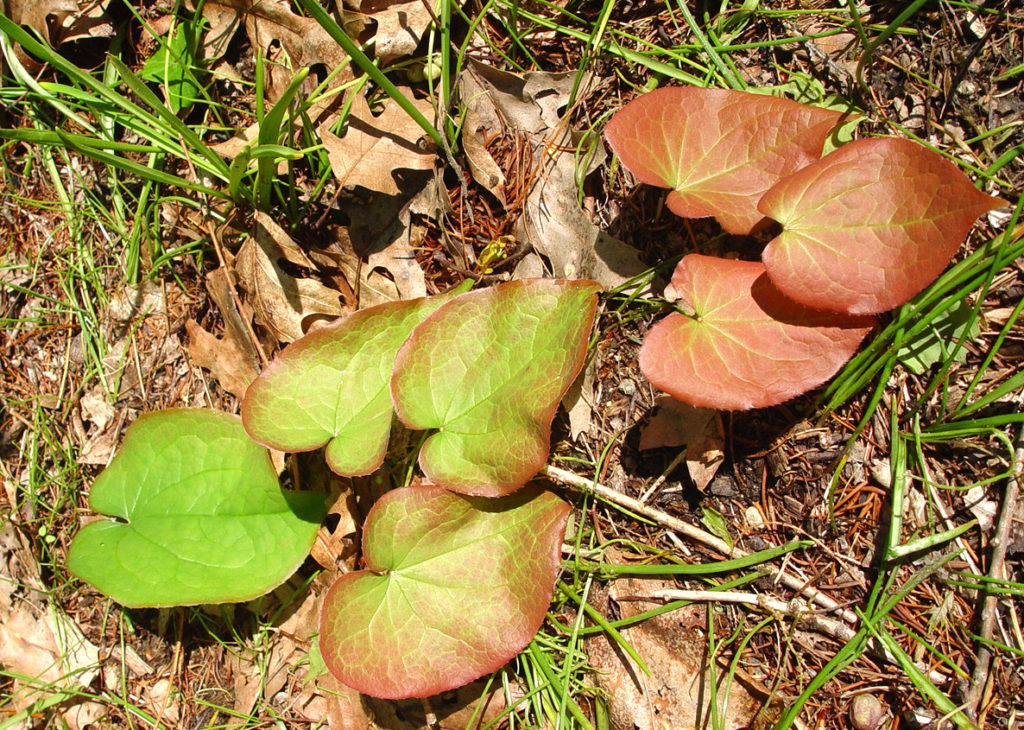
Epimediums grow by underground woody rhizomes, and do not tolerate poor drainage. The length of annual rhizome growth determines whether they will colonize an area, or remain in a clump. All varieties listed are clump-forming (look under the Find Plants tab in the Header/By Growth & Habit/ Clump-forming) unless otherwise noted. Spreading types are so indicated in their description. I also list the typical annual rhizome growth under optimal conditions in our climate (central Massachusetts, USDA hardiness zone 5b). You can use this information to determine how long it will take each plant to reach the desired size. Growth will vary in different parts of the country, depending on growing conditions and length of season. Although some spread, I do not consider them invasive. They are also not favored by deer, although I have heard sporadic reports of deer eating the newest growth. Heights range from 6” to 2.5’, but are most commonly from 12″ to 18″. Clump forming types usually mature after 3-4 years to a plant that is as wide as it is tall, unless otherwise noted. In subsequent years clump-formers will gradually widen so that they are a bit wider than they are tall. Use these general guidelines to help you with spacing the plants out in your garden when planting.
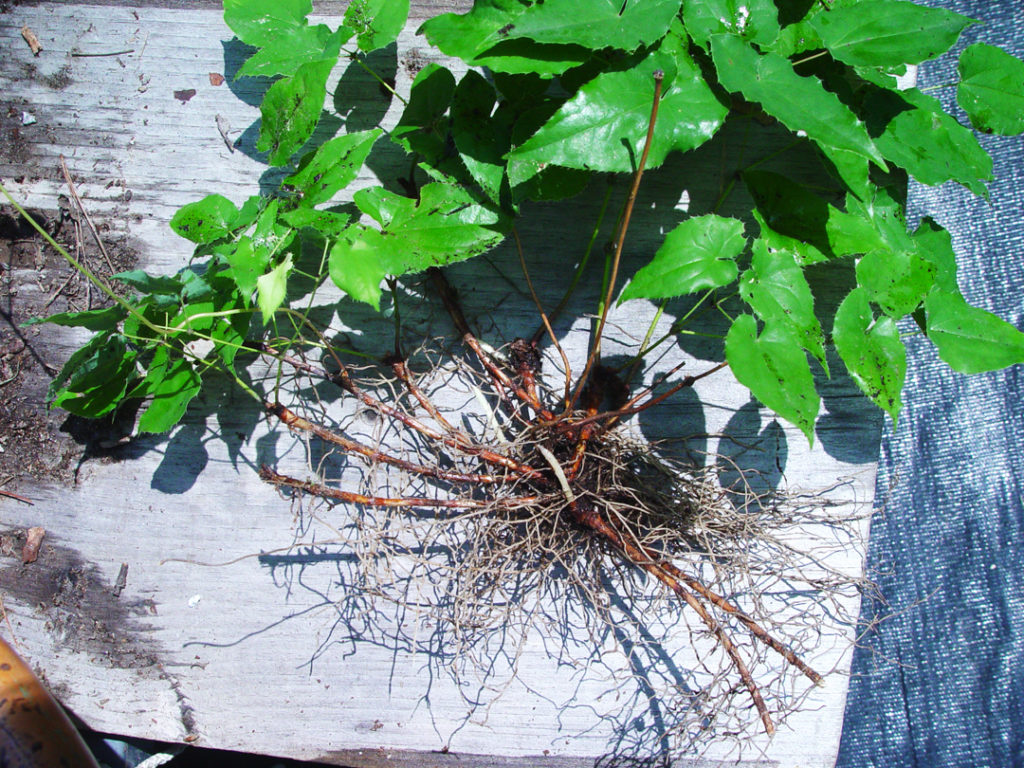
Hardiness: Unless otherwise stated in their descriptions, ALL plants offered here have thrived in our nursery (USDA Zone 5b), although we usually have snow cover in winter. Many of these species/varieties are new to cultivation and have not been tested as to their environmental limits elsewhere. Customers in extreme weather areas often ask for suggestions as to which Epimediums will grow in their climate. For those gardening in USDA Zones 8 & 9, we suggest you first try plants categorized as heat-tolerant (look under the Find Plants tab in the Header/By Growth & Habit/ Heat Tolerant). Those in Zones 3 & 4 are advised to start with plants categorized as cold-tolerant (look under the Find Plants tab in the Header/By Growth & Habit/ Cold Tolerant). Epimediums do not tolerate rapid and repeated freezing and thawing such as commonly occurs in both fall and spring, (take note trough gardeners!) especially if their rhizomes are exposed. We recommend at least a few inches of mulch and caution against holding the plants in pots over winter—it is very risky!
Flowers: Epimediums have delicate flowers that bloom in late April/May in Massachusetts. They come in a kaleidoscope of colors including white, yellow, purple, orange, red, and many shades in between. Their intriguing form is reminiscent of columbine, and most often composed of 4 inner sepals, a cup and 4 spurs. We define size as follows: Small= 1/4” to 3/4”; Medium= 7/8”to 1-3/8”; Large= 1-1/2” to 2+”. Flowers are borne above the leaves unless otherwise noted. The size of individual flower parts determines showiness, e.g. we describe the flowers of E. sagittatum as tiny (narrow parts), and those of E. alpinum as very small (wider parts), even though they are of the same diameter.
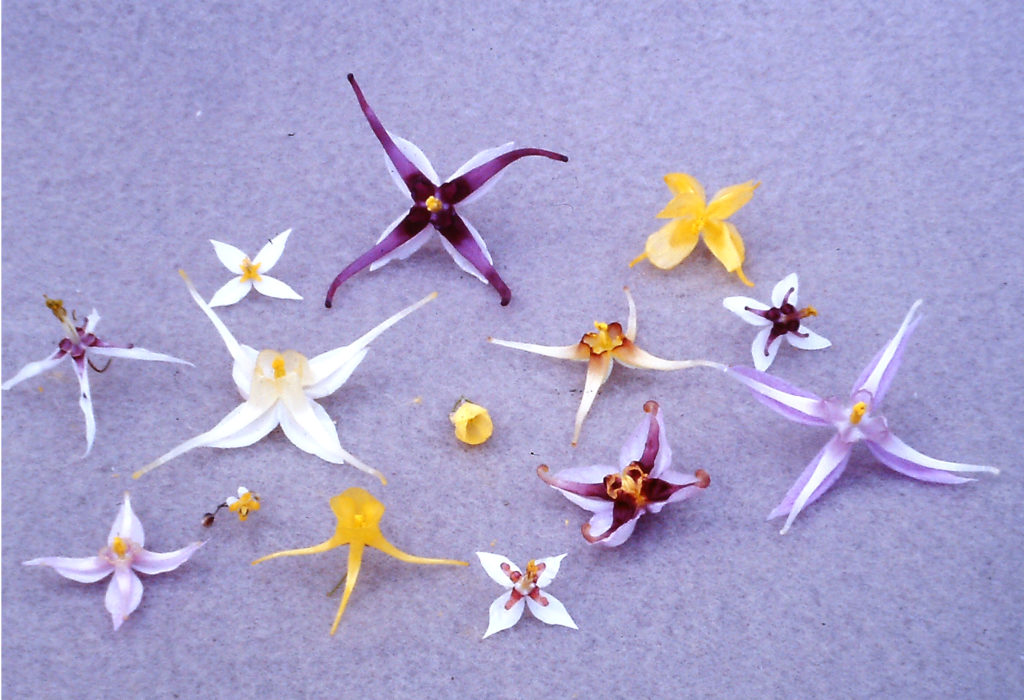
Leaflets: Size is difficult to generalize, as there can be a considerable range on a single plant. Unless otherwise noted, leaves are compound, and composed of from 3 to 27+ leaflets. Leaflets under 2” = Small; Medium= 2 to 4”; Large= 4 to 6”; Huge= 6”+. Many Epimediums also display spectacular but ephemeral spring foliage colors that repeat on leaves produced during secondary growth flushes. Some even display attractive fall foliage colors.
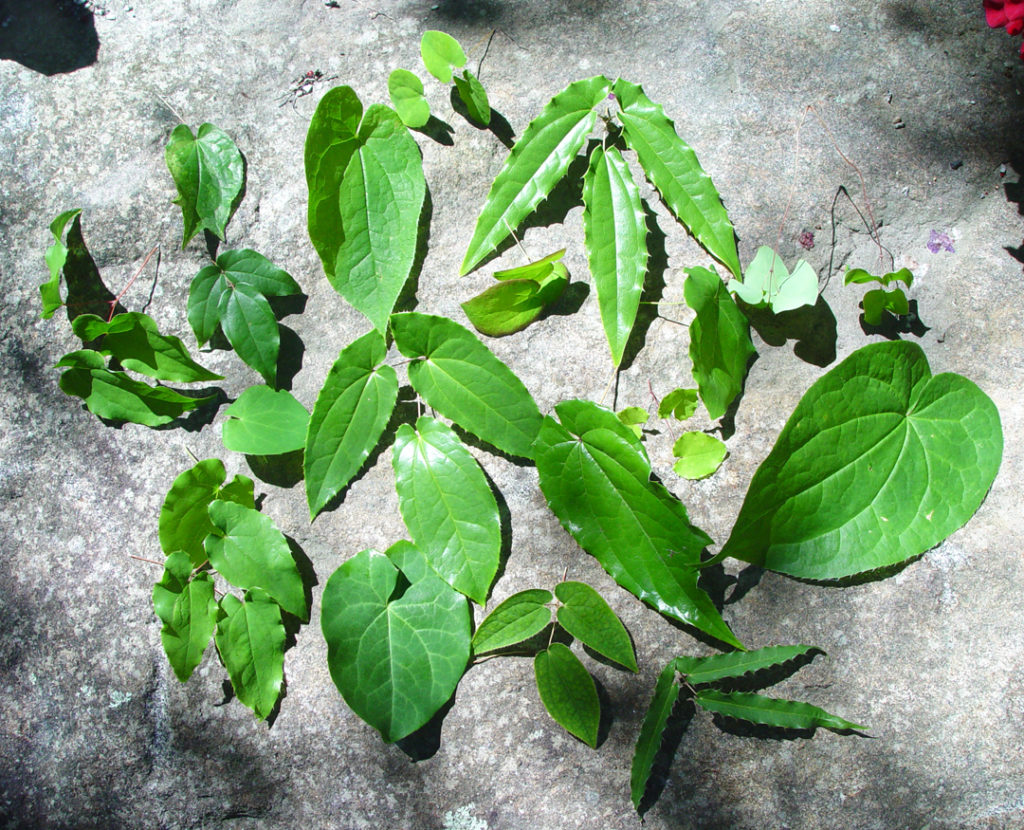
Evergreen/deciduous: Best described by Don Elick when referring to E. sempervirens and E. grandiflorum in his book Japonica Magnifica. “The real difference lies not in when, but in the way the leaflets go over: the deciduous ones fall away clean, however belatedly, whereas the evergreen ones decay on the stems, never fall, not even when a net of fibers is all that remains.” In USDA Zone 7 and warmer areas, the foliage of true evergreen types remains relatively intact over winter unless sited in an exposed area where it may suffer sunburn and desiccation. In colder areas, the leaflets of evergreen types often remain showy through December. Unless still attractive in spring, remove the previous year’s leaves before the new growth emerges to avoid damaging the tender young stems. Leaving the previous year’s growth intact encourages the growth of larger/taller plants with more robust leaves and flower scapes. New growth typically extends above the old growth, and if desired, the latter can be removed later, after the new growth matures. All varieties listed are deciduous, unless the description specifically states evergreen or semi-evergreen. Semi-evergreen types have foliage that persists in good condition after the initial round of hard frosts, but burns as winter comes on in earnest.
Propagation

I receive many inquiries about propagating Epimediums. Propagation is not done any differently than for any other herbaceous perennial, except for the fact that they are actually a woody plant, which makes them a little tougher to handle.
The best time to divide the deciduous varieties is just as the shoots are emerging (second best time is when the plants are starting to go dormant in early fall- where you would cut back 1/3 of the foliage to make up for destroying a portion of the roots). Handle them with care at this stage as the newly formed shoots are very brittle. The smaller the new buds are when you dig up the clump, the easier it is to handle without damaging the new growth.
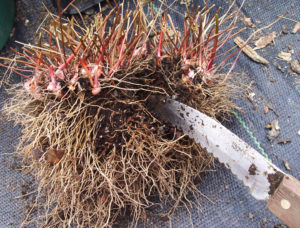
I dig up the clump and divide it with a sharp shovel, shears, a soil or root “knife”, or scissors depending on how finely I want to divide it. Attach a spray nozzle to the end of a hose and spray some off some of the soil surrounding the roots in order to better see what you are doing. Or you can leave the clump in the ground and saw off a portion of the mass of woody rhizomes (on clumping varieties) with a root knife (pictured) or a section of running woody rhizomes on the spreading types. By doing this, you won’t disturb the roots of the rest of the clump.
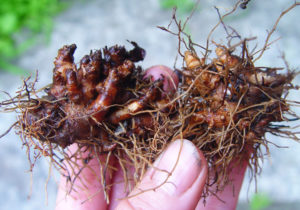
Relocate the division to another part of your garden, and make sure that the underground woody stems or rhizomes are covered by 1/2″ to 1.5″ of soil. Mulch lightly and water in well. Keep it watered during the first few months while it is establishing roots. If the area in which it is planted gets any full sun during the day, provide a shade covering for the first month or so until the plant gets established.
One thing that is different for Epimediums than most other perennials is that they are very sensitive to harsh chemical fertilizers, so don’t sprinkle your 10-10-10 lawn fertilizer on them. If the soil into which it is being planted is poor, it may help to put 1 tsp of a low nitrogen fertilizer such as Hollytone sprinkled into the planting hole, with another 1/2 teaspoon sprinkled on the surface of the soil, about 2″ out from the stem. Working organic matter into the bed before planting works too. Better to err on the side of less is more, than risk burning your plants. I never fertilize the plants that I have growing in the ground. The mulch I apply to the beds rots in and gives the Epimediums all the nutrients they need.
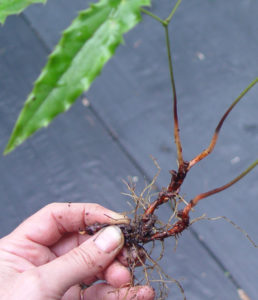
Another tip is to propagate the Chinese evergreen species after their foliage hardens off in spring. That is usually late June here in northern Massachusetts. I find that keeping foliage on all of my divisions helps with survival. Treat these divisions as you would fall divisions for the deciduous types, that is, cut back 1/3 of the foliage to compensate for the damaged root system.
All propagation done on the premises
I propagate all of the Epimediums by division (no Epimediums are “bought in” for resale) to offer what is by far this country’s largest selection. Plant descriptions within this catalog remain sprinkled with snippets from Darrell’s adventures on his collecting trips to Asia. We will continue to convey useful information on the genus as to identity, and our experience and knowledge in growing the plants.
Photos taken by Karen Perkins or Darrell Probst unless otherwise noted.